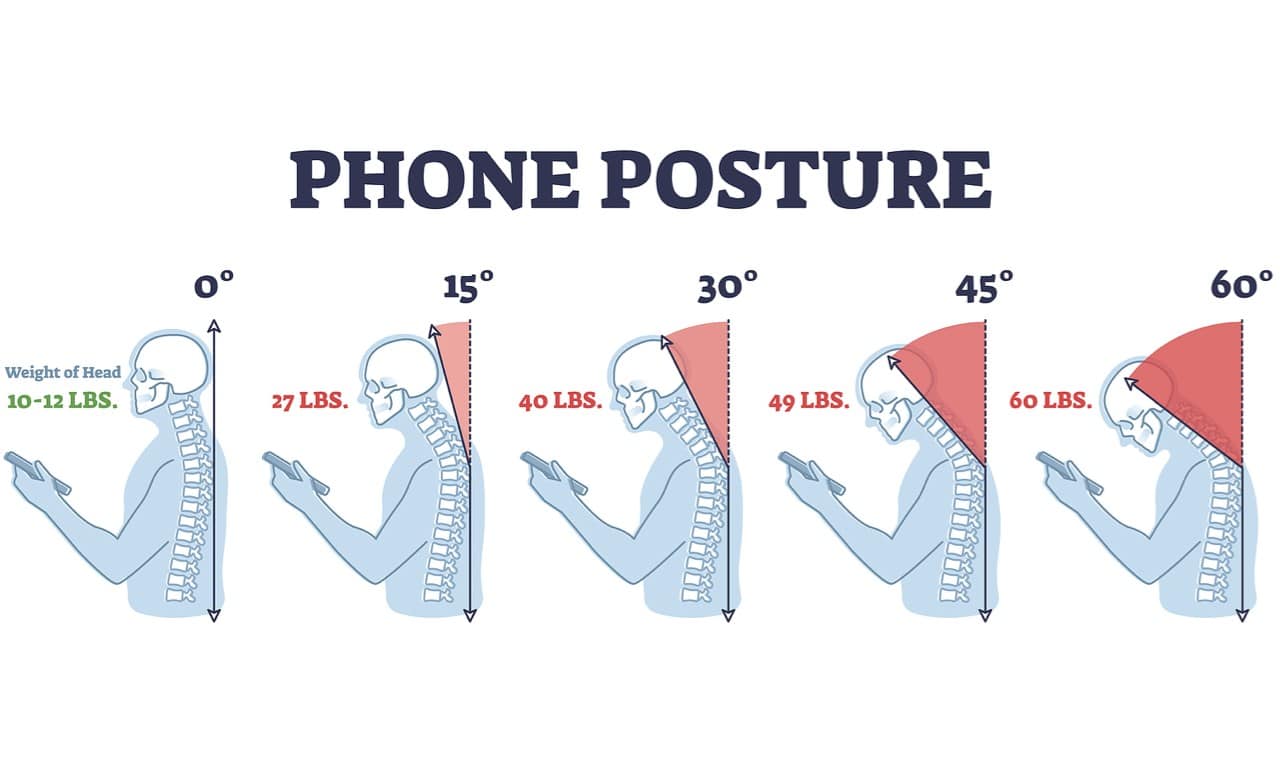
Smart phones have become a part of our daily lives and we literally have movies, games, the internet, countless helpful apps and texting at our fingertips. But all of this convenience has left us with some bad habits that can have some health consequences.
We tend to hold our phones in front of our bodies and not in front of our eyes, which means we look down to see our screens. This is called forward head posture or, more commonly, text neck. The lower you hold your phone, the more you have to bend your neck forward to look down. The further you look down, the more load is put on your neck muscles and ligaments. This added strain on your neck can cause pain and stiffness because it overworks some muscles and weakens other muscles, weakens ligaments, and decreases your neck motion. This forward head posture also puts you at more risk for numbness or tingling into the arms, disc herniations, and cervical spinal arthritis. For every inch, our head is forward, 10 pounds of weight is felt in the neck. A neutral head has 10-12 lbs of weight on the neck, whereas looking down feels like 60 lbs!
When your head is forward or when you look down for prolonged periods, your shoulders roll forward, and your mid-back (thoracic) spine flexes forward, causing a kyphosis or hunched back. Besides this posture making you look like you are 100 years old, it also can cause pain in the mid-back, between the shoulder blades, and in the upper traps. In addition, this rounded shoulder posture shortens the chest muscles, or pecs, which can reduce shoulder range of motion and causes numbness or tingling into the arms.
The overworked muscles from our forward head posture can refer pain to the head causing tension headaches. We can also get headaches from straining to see those small screens. Eye strain, blurry vision, and blue light exposure can all lead to headaches, especially if using our phones in a dark room.
Tight muscles and clenching can be associated with forwarding head posture and rounded shoulders, which may lead to temporomandibular joint (TMJ) disorders and jaw pain. When our heads are forward, it causes some neck and head muscles to be overstretched or pull on the jaw.
The combo of forwarding head posture and rounded shoulders can lead to breathing problems due to poor breathing patterns and decreased lung capacity. Forward head posture weakens the diaphragm strength and the accessory breathing muscles, like the scalenes. The rounded shoulders increase the thoracic kyphosis, limiting the lung capacity by creating less room for our chests to take a full breath.
Stand sideways and get another person to look at you or take a picture for you.
Check for the following:
Chiropractic: Posture problems wreak havoc on your spine and other joints. Over time, some joints become less mobile and stiff, whereas other areas become hypermobile. By adjusting the immobile areas, more balance is achieved throughout the spine and joints. The cervical spine, thoracic spine, and shoulder girdle are common areas that need attention.
Rehab Exercises: Strength and flexibility are the names of the game for correcting forward head posture. Building up strength in posture supporting muscles like rhomboids, deep neck flexors, and erector muscles will help reduce forward head posture and rounded shoulders. In addition, stretching shortened muscles such as the pecs and traps will help stop the tug of war between your body.
Home Exercises & Ergonomics: Giving you simple ergonomic changes for out and about, for at work, for at school, or for at home will help reinforce good posture. Home exercises like chin tucks and wall angels are a good start for resetting posture and building up strength.
For more information, here is a study that goes into more detail about what we are covering in this blog post.
Reference